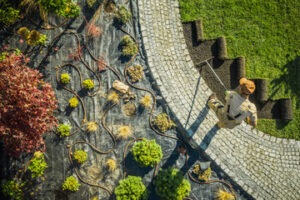Jupiter Landscaping is the art of adding beauty to outdoor spaces. It combines creativity and practicality to create functional, sustainable garden areas and entertainment spaces.

It raises property value, provides environmental benefits, and adds to the enjoyment of your home or business. Proper landscape design uses principles of balance, proportion, and unity to achieve harmony between your dwelling and its surroundings.
Landscape design is the process of planning and implementing various elements to create aesthetically pleasing, harmonious environments. It can be applied to residential yards, commercial properties, public spaces, and more. Residential landscape design often involves a mix of hardscapes and softscapes, such as flowers, trees, shrubs, grass, and garden beds. It also includes features like patios, walkways, and driveways, as well as retaining walls and water features.
The right landscaping can make your home or business stand out from the crowd, add value to your property, and increase its functionality. The first step in a successful landscaping project is creating a landscape plan, which outlines the layout of your outdoor space and how it will be used. It should take into account the existing conditions and factors, such as sunlight, rainfall, wind direction, and soil type. It should also include a list of the plants and materials you want to use, as well as their specific requirements and maintenance needs.
Once you’ve created a plan, it’s time to start the actual construction work. This part of the process is sometimes referred to as “landscape construction,” and it entails activities like building pathways, installing retaining walls, constructing outdoor structures (like patios, decks, and pergolas), and implementing irrigation systems. Landscaping construction projects typically require a permit and strict compliance with local codes and regulations.
One of the biggest trends in landscape design is minimalism, which emphasizes simplicity and clean lines. This style is perfect for homeowners who prefer a low-maintenance, easy-to-care-for landscape. It’s also a great choice for those who want to minimize their environmental footprint.
Another popular trend in landscape design is incorporating rewilding and biophilic principles into the landscape. These are concepts that promote biodiversity and encourage people to connect with nature. This can be achieved by adding features like wildflower meadows, ponds, and other water features that support local wildlife.
Plantings
A landscape isn’t complete without a good mix of plantings. From ground cover and ornamental grasses to shrubs and perennial flowers, these plants add texture, color, and interest to the overall design. They can also create a dramatic effect by creating visual contrasts with their colors and textures. For example, pairing yellow flowering plants with green foliage can create a dynamic effect, while the soft lavender hues of Russian sage can have a soothing effect.
A plant’s function and maintenance needs should also be considered when choosing the best planting for an area. For example, a plant may be needed to provide shade for reducing summer air conditioning costs or as a wind break to block undesirable views. Other factors that influence the type of plants used in a landscape include soil moisture, deer resistance, salt tolerance, and the desired aesthetic of the space.
The color, texture, and shape of a plant can create a variety of different effects in the garden. Color can create movement and excitement, while textures can provide depth and dimension. Plants that require low maintenance are often used as accents to draw attention to focal points in a landscape. These plants can be planted in groups or as scattered accents throughout the landscape.
Using native plants can make your yard more attractive and sustainable. Native plants are adapted to the local climate, soil conditions, and pests, making them easier to maintain. They can also provide environmental benefits such as mitigating stormwater runoff and preventing fertilizers from entering a water body.
Another way to create a beautiful landscape is by utilizing the principles of scale and pacing. This involves combining tall plants, such as trees, with low-growing plants, such as shrubs and ground covers. It is important to balance these elements to achieve a balanced look that is both pleasing to the eye and functional.
Layering is a popular landscaping technique that uses plants of varying heights to create depth in the landscape. It is achieved by placing taller plants toward the back of the garden and progressively layering lower-growing plants as you move forward. It can also be used to create privacy and define spaces. For example, a shrub can be planted in front of a perennial flower bed to provide height and privacy for the flowers behind it.
Hardscapes
Unlike plants, trees and shrubs that come and go with the seasons, hardscapes like pathways, patios, decks and retaining walls offer a more stable and permanent structure to your landscape. These elements can be a focal point in your design or blend in seamlessly with the other elements to create one cohesive picture that will boost your home’s curb appeal and property resale value.
There are a wide variety of hardscapes to choose from, including stone, brick, concrete pavers, natural clay tile and even recycled materials such as asphalt and wood. Concrete is an exceptionally versatile material that can be stained, stamped and embedded with other materials to add a unique and creative touch. It is also extremely durable and can be used to create a variety of outdoor features, such as pathways, driveways, patios and fire pits.
As the name suggests, hardscapes are structural in nature and can be built as part of a large project or implemented in phases as you grow into your landscaping goals. They include elements like fences to provide privacy and security as well as decks and gazebos for dining, relaxing and entertaining. Hardscapes can also be used to solve outdoor challenges, such as enhancing accessibility with walkways and paved areas and ensuring proper drainage by building retaining walls or terraced gardens.
The best modern hardscaping projects incorporate both hard and softscape elements to make a statement. The perfect balance between the two provides a beautiful and functional landscape that will be enjoyed for years to come. Hardscapes are a great way to add a pop of color, texture and contrast to your landscape. They also complement and contrast your plantings to help them stand out.
Before you start your project, it is important to consider the amount of maintenance you are willing to commit to. Keep in mind that plants and grass will need to be replaced yearly, and trees and shrubs will need pruning and trimming. Then decide on the hardscapes and softscapes that will fit your lifestyle and budget. Incorporate unique paver shapes and colors, smart technology, multifunctionality and statement pieces to create a contemporary sanctuary that you will love for years to come.
Lighting
Landscape lighting brings a whole new dimension to your home’s nighttime curb appeal. It accents features that aren’t easily seen in the day, such as a stone wall or fountain, and creates a welcoming ambiance for evening guests. In addition, lighting can be used to provide safety and visibility on walkways and garden paths.
Up-lighting, a common technique in landscape lighting design, highlights tall garden structures and architectural columns. It also draws attention to statues, sculptures and other ornamental elements. Spot lights, well lights and low-voltage landscape flood lights are all effective options for up-lighting.
Down-lighting, a popular landscape lighting design technique, focuses light downward to eliminate shadows on a surface. It works best with textured walls and other vertical features, such as retaining walls and garden steps. Spot lights and low-voltage landscape flood lights can be used for this purpose, but be careful when placing them near plant species that might grow over the fixture and block its light.
Grazing is a landscape lighting design technique that highlights a textured surface by creating interesting shadows. It is often used to highlight garden statues, architectural columns and other elements that rise above the ground. Spot lights, well lights and low-voltage garden flood lights are commonly used for this purpose.
A grazing effect can be enhanced by using a “wall washing” technique. This involves bathing an entire building facade or long row of bushes in a soft glow.
This effect is meant to mimic the look of natural moonlight. It is achieved by mounting spot lights or low-voltage landscape flood lights high in trees and angling them downward to cast a soft, natural glow around the object being illuminated.
Path lights are used to illuminate walkways and guide homeowners and visitors around the property. They can be installed along garden beds to illuminate colorful plantings under the stars, or they can be used to line driveways or paths for improved safety and added security. The light they produce also helps deter burglars and other unwanted intruders. Many path lights can also be dimmed and controlled with a smartphone app to increase energy efficiency.

